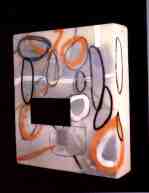Blogs and thought
Quantum shorts, Newton's gate space orbit's, education and security risk and pillbox's.
A short essay on instructional design theory.
Art and politics excerpt referring to historian John Canaday.
Indy producers
St James MediaStudio
Blogs and thought
Quantum shorts, Newton's gate space orbit's,
education and security risk and pillbox's.
A short essay on instructional design theory.
Art and politics excerpt referring to historian
John Canaday.
Indy producers
ART THEORY: POSTMODERN and CONTEMPORARY FINE ART for Dr. Marc Cirigliano, ESC Mentor by Jardean W. St. James,
Art history has always had a somewhat theoretical characteristic. Consider our modest Upper Paleolithic, Northern Spanish ‘objective oriented’ beginnings in cave painting, for example. Were those artists practicing sorcery, decorum or both? Italian artist Tiziano Vecellio is among the many more recent following early Cro-Magnon craft. Technology and art has always led the way in culture.01. Photography the industrial revolution brought forth new thinking about the arts. Gustave Klimpt, Pierre Bonnard, Edouard Manet and John Singer Sargent are among artists who are of comparable notoriety. Similarly, they occur in history of sociological symbolism and anthropological rite, in scales and importance and in recurrent cycles of evolutionary painting. They have measurably comparable life cycles of experience. Data supporting this assertion can be substantiated by recent neurobiology findings. In many ways and each had close personal experiences, with the technologies of their own times, and the expressivity to create important statements and reactions to them. While theory has long held importance in scientific aspect, simple figurative representation is only giving way to cycles of more rigorous theoretical application in some arts. For instance, it may readily be observed that Bonnard was very experimental in his approach to fine art. He replaced ‘artificial perspective’ with recordings of ‘natural vision.’ Pierre sought to paint the feeling of ‘visual entirety.’ For him "everything sparkles…the work of art, a stopping of time."02. Contemporary artist Chuck Close reaching for the ‘nth degree’ in expression strives for ‘unconscious optical’ portraiture effects intensified with the camera.03. In addition to serious new scientific effort, what questioning or generic analyses are required to advance the state of visual arts?
Depending upon what the search is for, compelling hypotheses can be drawn such that human affinity in general, affinities for display and characteristics themselves can characterize art theory. Its integral nature is both affinite and timelessly proportioned. Art theory is cosmic. It is plastic and flexible. Art theory can be progressive. It could be expected to occur on a standard regression curve.04. Social philosophies of artistic practice can be placed within a social, sociological or even scientific continuum. The humanity, art theory under modern re-examination, includes recent great artists such as Sargent, Picasso, Warhol, Lichenstein, Rothko, Stella, Poons, Rauchenberg and Dali who were social respondents to society and also scientific studies in themselves.
The simplest miscalculations are often fabricated emotional constructs made by complex individuals. Inaccurate information when elaborated regularly leads many to misperception, misinterpretation and to misconception of reality. The perception of ghost's, slight of hand magic, evil curses, ‘ET’s’ from the future, ESP, time travel events and many other occult occurrences are aegis’s of misconception. Confusion, the standard error ellipse applied within a Jacobian matrix network, graph theory or places where time functions should be evaluated precisely at [(x’ = x + v t)] can produce a typical ‘half-light’ scenario, for instance. Illusion and the reality of the persistence of vision effect seem an adequate corollary explanation to these pseudo-events.05. It is easy to confirm this suspicion using typical ‘pencil of lines’ extrapolations and simple rules of thumb.06
These problems are precisely what one would expect from a close analysis of a typical Galilean transform schedule, from physics, or in playful creative impulses of general possibility. For example, alternatively, a more scientific social transaction system of behavior might produce constructive invention and development. Such was the laser equation, the laser light and the laser system, simply because distorted information was minimized. As counterpoint and contrasting scenario might be possibilities of making random assumptions about the moon without telescopic aid or comparing the results of ortho-lighting against subject backlighting, and thereby magnifying some affinity. Social systems and conditions fluctuate: generating, degenerating and regenerating. Such progress and variations are correctly functions of specific limits on possibility, inputs, expectations and social dynamics. This is the case as our interpretation of fluctuating velocity and time, too. In controlled experiments and in reality one can get perception, but not without misperception. They are sometimes misperceived and transformed into added ‘useless’ work. These laws and principles of content to context error apply to ‘graph theory.’ One example might be a better graph producing a better prediction, perhaps to follow an affinity along further.

*Andrew Bick’s painting Bickbig reproduced here without permission for educational purposes only.
Tracing backwards to a source, in the energy theory schema, energy may take the form of information. Therefore, energy can be characterized by general theories. It is representational and can not be created or destroyed. The measure of the average kinetic energy of something, such as a social system, would be equal to its thermodynamic temperature.07. This relationship comprises a typical energy utility schematic, which would be capable of undergoing typical curve fitting techniques, such as closing a significance curve, producing solution sets and so forth. Information inversely related to disorder. Quoting Heraclitus, from ancient Greece, "All things flow, nothing abides;" "less is more" according to Robert Browning.08, 09. " All this equates to the development of genetic economies of scale (geno-economies or bio-economics) and systems. Like a Gibbs-Helmholtz equation or Galilean-Lorentz projection, Jacobs, Lorentz, Norbert Wiener and Hamiltonian thermodynamic relationships, act like locomotive pistons imparting work to a social wheel imagined between academia and reactionary parties. Energy current exchanges between several systems